|
NSDI '05 Paper
[NSDI '05 Technical Program]
Trickles: A Stateless Network Stack for
Improved Scalability,
Resilience, and Flexibility
Alan Shieh
Andrew C. Myers
Emin GŁn Sirer
Dept. of Computer Science
Cornell University
Ithaca, NY 14853
{ashieh,andru,egs}@cs.cornell.edu
Abstract:
Traditional operating system interfaces and network protocol
implementations force system state to be kept on both sides of a
connection. Such state ties the connection to an endpoint, impedes
transparent failover, permits denial-of-service attacks, and limits scalability.
This paper introduces a novel TCP-like transport protocol and a new
interface to replace sockets that together enable all state to be kept
on one endpoint, allowing the other endpoint, typically the server, to
operate without any per-connection state. Called Trickles,
this approach enables servers to
scale well with increasing numbers of clients, consume fewer
resources, and better resist denial-of-service attacks.
Measurements on a full implementation in Linux indicate that Trickles achieves
performance comparable to TCP/IP, interacts well with other flows, and
scales well. Trickles also enables qualitatively different kinds of networked
services. Services can be geographically replicated and contacted
through an anycast primitive for improved availability and
performance. Widely-deployed practices that currently have
client-observable side effects, such as periodic server reboots,
connection redirection, and failover, can be made transparent, and
perform well, under Trickles. The protocol is secure against
tampering and replay attacks, and the client interface is
backwards-compatible, requiring no changes to sockets-based client applications.
1 Introduction
The flexibility, performance, and security of networked systems depend
in large part on the placement and management of system state,
including both the kernel-level and application-level state used to provide a service. A
critical issue in the design of networked systems is where to locate,
how to encode, and when to update system state. These three aspects of
network protocol stack design have far reaching ramifications: they
determine protocol functionality, dictate the structure of
applications, and may enhance or limit performance.
Consider a point-to-point connection between a web client and
server. The system state consists of TCP protocol parameters, such as
window size, RTT estimate, and slow-start threshold, as well as
application-level data, such as user id, session id, and
authentication status. There are only three locations where state can
be stored, namely, the two endpoints and the network in the
middle. While the end-to-end argument provides guidance on where not
to place state and implement functionality, it still leaves a
considerable amount of design flexibility that has remained largely
unexplored.
Traditional systems based on sockets and TCP/IP distribute session
state across both sides of a point-to-point connection.
Distributed state
leads to three problems. First, connection failover and recovery is
difficult, non-transparent, or both, as reconstructing lost state is
often non-trivial. Web server failures, for instance, can lead to
user-visible connection resets. Second, dedicating resources to
keeping state invites denial of service (DoS) attacks that use up
these resources. Defenses against such attacks often disable useful
functionality: few stacks accept piggybacked data on SYN packets,
increasing overhead for short connections, and Internet servers often
do not allow long-running persistent HTTP connections, increasing
overhead for bursty accesses [8]. Finally,
state in protocol stacks limits scalability: servers cannot scale up
to large numbers of clients because they need to commit per-client
resources, and similarly cannot scale down to tiny embedded devices,
as there is a lower bound on the resources needed per connection.
In this paper, we investigate a fundamentally different way to
structure a network protocol stack, in which system state can be kept
entirely on one side of a network connection. Our Trickles protocol
stack enables encapsulated state to be pushed from the server to the
client. The client then presents this state to the server when
requesting service in subsequent packets to reconstitute the
server-side state. The encapsulated state thus acts as a form of
network continuation (Figure 1). A new server-side interface to the network
protocol stack, designed to replace sockets, allows network
continuations to carry both kernel and application level state, and
thus enables stateless network services. On the client side,
a compatibility layer ensures that sockets-based clients can
transparently migrate to Trickles. The use of the TCP packet format at
the wire level reduces disruption to existing network infrastructure,
such as NATs and traffic shapers, and enables incremental deployment.
A stateless network protocol interface and implementation have many
ramifications for service construction. Self-describing
packets carrying encapsulated server state enable services to be
replicated and migrated between servers. Failure recovery can be
instantaneous and transparent, since redirecting a
continuation-carrying Trickles packet to a live server replica will
enable that server to respond to the request immediately. In the
wide area,
Trickles obviates the key concern about the suitability of anycast
primitives [3] for stateful connection-oriented
sessions by eliminating the need for route stability.
Server replicas can thus be
placed in geographically diverse locations, and satisfy client requests
regardless of their past communications history. Eliminating the client-server binding
obviates the need for DNS redirection and reduces the
potential security vulnerabilities posed by redirectors. In wireless
networks, Trickles enables connection suspension and migration to be
performed without recourse to intermediate nodes in the network to
temporarily hold state.
A stateless protocol stack can rule out
many types of denial-of-service attacks on memory resources.
While previous work has examined how to thwart DoS attacks targeted at
specific parts of the transport protocol, such as SYN floods, Trickles
provides a general approach applicable for all attacks against
kernel and application-level state.
Overall, this paper makes three contributions. First, it describes the
design and implementation of a network protocol stack that enables
all per-connection state to be safely migrated to one end of a network
connection. Second, it outlines a new TCP-like transport protocol and
a new application interface that facilitates the construction of
event-driven, continuation-based applications and fully stateless
servers. Finally, it demonstrates through a full implementation that
applications based on this infrastructure achieve performance
comparable to that of TCP, interact well with other TCP-friendly flows,
and scale well.
The rest of the paper describes Trickles in more detail.
Section 2 describes the Trickles transport protocol.
Section 3 presents the new stateless server API, while
Section 4 describes the behavior of the client.
Section 5 presents optimizations that
can significantly increase the performance of Trickles.
Section 6 evaluates our Linux implementation.
Section 7 discusses related work and
Section 8 summarizes our contributions and their
implications for server design.
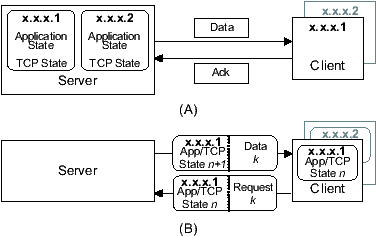
Figure 1: TCP versus Trickles state. (A) TCP holds state at server,
even for idle connection x.x.x.2. (B) Trickles encapsulates and ships
server state to the client.
2 Stateless Transport Protocol
The Trickles transport protocol provides a reliable,
high-performance, TCP-friendly stream abstraction while placing
per-connection state on only one side of the connection.
Statelessness makes sense when connection characteristics are
asymmetric; in particular, when a high-degree node in the graph
of sessions (typically, a server)
is connected to a large number of low-degree nodes (for example,
clients). A stateless high-degree node would not
have to store information about its many neighbors. For this reason
we will refer to the stateless side of the connection as the server and
the stateful side as the client, though this is not the only way to
organize such a system.
To make congestion-control decisions, the stateless
side needs information about the state of the connection,
such as the current window size and prior packet loss.
Because the server does not keep
state about the connection, the client tracks
state on the server's behalf and attaches it to requests sent to the server. The updated connection state
is attached to response packets and passed to the client. This piggybacked state is called a continuation
because it provides the necessary information for the server to later
resume the processing of a data stream.
The Trickles protocol simulates the behavior of the TCP
congestion control algorithm by shipping the kernel-level state, namely
the TCP control block (TCB), to the client side in a transport
continuation. The client ships the transport continuation back to
the server in each packet, enabling the server protocol stack to regenerate
state required by TCP congestion control [26].
Trickles also supports stateless user-level server applications; to
permit a server application to suspend processing without retaining
state, the application may add an analogous user continuation to
outgoing packets.
During the normal operation of the Trickles protocol, the client
maintains a set of user and transport continuations. When the
client is ready to transmit or request data, it generates a packet
containing a transport continuation, any loss
information not yet known to the server, a user continuation, and any user-specified data.
On processing the request, the
server protocol stack uses the transport continuation and
loss information to compute a new transport continuation.
The user data and user continuation are
passed to the server application, along with the allowed response size.
The user continuation and data are used by the application to compute the response.
With Trickles, responsibility for data retransmission lies with the
server application, since a reliable queuing mechanism, such as
that found in TCP implementations, is stateful and holds data in a send buffer until it is acknowledged.
Therefore, a Trickles server application must be
able to reconstruct old data, either by supporting (stateless)
reconstruction of previously transmitted data, or by providing its own
(stateful) buffering. This design allows applications to
control the amount of state devoted to each connection,
and share buffer space where possible.
2.1 Transport and user continuations
The Trickles transport continuation encodes the part of the TCB
needed to simulate the congestion control mechanisms of the TCP state
machine. For example, the continuation includes the packet number, the
round trip time (RTT), and the slow-start threshold (ssthresh). In
addition, the client attaches a compact representation of the losses
it has incurred. This information enables the server to recreate an
appropriate TCB. Transport continuations are 75 + 12 m bytes, where
m is the number of loss events being reported to the server (usually
m=1). Our implementation uses delayed acknowledgments,
matching common practice for TCP [1].
The user continuation enables a stateless server application to
resume processing in an application-dependent manner. Typically,
the application will need information about what data object
is being delivered to the client, along with the current position
in the data stream. For a web server, this might include the URL of the requested page (or a lower-level
representation such as an inode number) and a file offset. Of course,
nothing prevents the server application from maintaining state where necessary.
2.2 Security
Migrating state to the client exposes the server to new
attacks. It is important to prevent a malicious user or third party
from tampering with server state in order to
extract an unfair share of the service, to waste bandwidth,
to launch a DDoS attack, or to force the server to execute an invalid
state [2]. Such attacks might employ two mechanisms: modifying the server
state---because it is no longer secured on the server, and performing
replay attacks---because statelessness inherently admits replay of
old packets.
Maintaining state integrity
Trickles protects transport continuations against tampering with a
message authentication code (MAC), signed with a secret key known only
to the server and its replicas. The MAC allows only the server to modify protected
state, such as RTT, ssthresh, and window size. Similarly, a server application should protect its state
by using a MAC over the user continuation. Malicious changes to
the transport or user continuation are detected
by the server kernel or application, respectively.
Hiding losses [19, 10] is a well-known attack on
TCP that can be used to gain better service or trigger a DDoS attack.
Trickles
avoids these attacks by attaching unique nonces to each packet.
Because clients cannot predict nonce values, if a packet is lost,
clients cannot substitute the nonce value for that packet.
Trickles clients signal losses using selective acknowledgment (SACK)
proofs, computed from the packet nonces, that securely describe the
set of packets received. The nonces are grouped by contiguous ranges,
and are compressed into a compact range summary that can be checked
efficiently. Let pi be packet i's nonce. The range [m,n] is
summarized by XORing together each pi in the range into a single word.
Imposing additional structure on the nonces enables Trickles
to generate per-packet
nonces and to verify multi-packet ranges in O(1)
time. Define a sequence of random numbers rx = f(K, x), where
f is a keyed cryptographic hash function. If
pi =
ri ⊕ ri+1,
then p1 ⊕
p2 ⊕ ... ⊕
pn =
r1 ⊕ rn+1. Thus, the server can generate and verify nonces with a constant number of rx computations.
Trickles distinguishes retransmitted packets from the original by using
a different server key K′ to derive retransmitted nonces. This suffices to
keep an attacker from using the nonce from the retransmitted
packet to forge a SACK proof that masks the loss of the original packet.
Note that this nonce mechanism protects against omission of losses
but not against insertion of losses; as in TCP, a client that pretends
not to receive data is self-limiting because its window size shrinks.
Protection against replay
Stateless servers are inherently vulnerable to replay attacks.
Since the behavior of a stateless system is independent of history, two identical packets will elicit the same response.
Therefore, protection
against replay requires some state. For scalability, this
extra state should be small and independent of the number of
connections. One possible replay defense is a simple hash table keyed on
the transport continuation MAC. This bounds the effect of a replay
attack, and if hash collisions indicate the presence of an attack, the
size of the hash table can be increased. The hash table records
recent packet history up until a time horizon. Each transport
continuation carries a server-supplied timestamp that is checked
on packet arrival; packets older than the time horizon are simply
discarded. Since the timestamp generation and
freshness check are both performed on the server, clock
synchronization between the client and server is not necessary.
The growth of the hash table is capped by
periodically purging and rebuilding it to capture only the packets
within the time horizon.
The replay defense mechanism can be implemented in the server kernel or in the
server application. The advantage of detecting replay in the kernel is that
duplicate packets can be flagged early in processing,
reducing the strain on the kernel-to-application signaling
mechanism. Placing the mechanism in the application is more flexible,
because application-specific knowledge can be applied.
For simplicity and flexibility, we have chosen to place replay
defense in the application. In either case, Trickles is more robust
against state-consumption attacks than TCP.
2.3 The trickle abstraction

Figure 2:
A sample TCP or Trickles connection.
Each line pattern corresponds to a different trickle.
Initially, there are cwnd trickles. At points where cwnd
increases (A, B), trickles are split.
Figure 2 depicts the exchange of packets
between the two ends of a typical TCP or Trickles connection. For simplicity,
there is no loss, packets arrive in order,
and delayed acknowledgments are not used.
Except where the current window size (cwnd) increases (at times A and B), the receipt
of one packet from the client enables the server to send one packet
in response, which in turn triggers another packet from the client,
and so on. This sequence of related packets forms a trickle.
A trickle captures the essential control and data
flow properties of a stateless server. If the server does not
remember state between packets, information can only flow forward
along individual trickles and so the response of the server to a packet is
solely determined by the incoming trickle. A stream of packets is
decomposed into multiple disjoint trickles; each packet is a member of
exactly one trickle. These trickles can be thought of as independent
threads that exchange information only on the client side.
In the Trickles protocol, the congestion control algorithm
at the server operates on each trickle independently. These
independent instances cooperate to mimic the congestion
control behavior of TCP. At a given time there are cwnd
simultaneous trickles. When a packet arrives at the server,
there are three possible outcomes. In the
common case, Trickles permits the server
application to send one packet in response, continuing the
current trickle. However, if packets were lost, the server may
terminate the current trickle by not permitting a response
packet; trickle termination reduces the current window size
(cwnd) by 1. The server may also increase cwnd by splitting the current
trickle into k > 1 response packets, and hence begin k - 1 new
trickles.
Split and terminate change the number of trickles and
hence the number of possible in-flight packets. Congestion
control at the server consists of using the client-supplied SACK proof to decide whether
to continue, terminate, or split the current trickle. Making Trickles match TCP's window size therefore reduces to
splitting or terminating trickles whenever the TCP window size changes.
When processing a given packet,
Trickles simulates the behavior of TCP at the corresponding
acknowledgment number based on the SACK proof, and then split or terminate trickles to generate
the same number of response packets. The subsequent sections describe how to
statelessly perform these decisions
to match the congestion avoidance, slow start, and
fast retransmit behavior of TCP.
2.4 Trickle dataflow constraints
Statelessness complicates matching TCP behavior, because it
fundamentally restricts the data flow allowed between the processing
of different packets. This restriction is the
main source of complexity in designing a stateless transport protocol.
Because Trickles servers are stateless, the server forgets all the
information for a trickle after processing the given packet, whereas
TCP servers retain this state persistently in the TCB.
Consider the comparison in Figure 3, illustrating
what happens when two packets from the same
connection are received in succession.
For Trickles, the state update from processing
the first packet is not available when the second packet is
processed at the point (B). At the earliest, this state update
can be made available at point (D) in the figure,
after a round trip through the client, during which
the client
fuses packet loss information
from the two server responses and sends that information back with
the second trickle. This example illustrates that
server state cannot propagate directly between the processing of
consecutive packets, but is available to server-side processing
a round trip later.
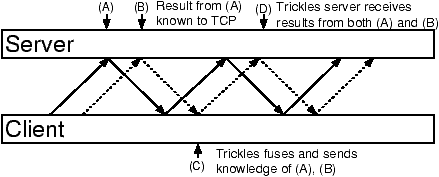
Figure 3: Difference in state/result availability between TCP and Trickles. TCP server knows the result of processing (A) earlier than Trickles server.
The round-trip delay in state updates makes it challenging to match the
congestion control action of TCP. Trickles circumvents the delay by
using prediction. When a packet arrives at the server, the server can
only know about packet losses that happened one full window earlier. It
optimistically assumes that all packets since that point have arrived
successfully, and accordingly makes the decision to continue, split, or
terminate. Optimism makes the common case of infrequent packet loss
work well.
Concurrent trickles must respond consistently and quickly to loss events.
By providing each trickle with the information needed
to predict the actions of other trickles, redundant operations are
avoided. Since the client-provided SACK proofs control trickle behavior,
we impose an invariant on SACK proofs to allow a later trickle
to infer the SACK proof of a previous trickle:
given a SACK proof L, any
proof L′ sent subsequently contains L as a prefix.
This prefix property allows the server to predict SACK proofs prior to L by simply computing a prefix.
Conceptually, SACK proofs cover the complete loss history, starting from the beginning of the connection. As an optimization to limit the proof size, a Trickles server allows the client to omit initial portions of the SACK proof once the TCB state fully reflects the server's response to those losses. This is guaranteed to occur after all loss events, once recovery or retransmission timeout finishes.

Figure 4: Equivalence of reverse and forward path loss in Trickles. Due to dataflow constraints, the packet following a lost packet does not compensate for the loss immediately. Neither the server nor the client can distinguish between (A) and (B). The loss will be discovered through subsequent SACK proofs.
With any prediction scheme, it is sometimes necessary to recover from
misprediction. Suppose a packet is lost before it reaches the server.
Then the server does not generate the corresponding response packet. This situation is indistinguishable from a loss of
the response on the server to client path: in both cases, the client receives no response (Figure
4). Consequently, a recovery mechanism for
response losses also suffices to recover from request packet losses,
simplifying the protocol. Note, however, that Trickles is more
sensitive to loss than TCP. While TCP can elide some ACK
losses with implicit acknowledgments,
such losses in Trickles require retransmission of the corresponding
request and data.
2.5 Congestion control algorithm
We are now equipped to define the per-trickle congestion control algorithm. The
algorithm operates in three modes that correspond to the congestion
control mechanisms in TCP Reno [1]: congestion
avoidance/slow start, fast recovery, and retransmit timeout. Trickles
strives to emulate the congestion control behavior of TCP Reno
as closely as possible by computing the target cwnd of TCP
Reno, and performing split or terminate operations as needed to move the
number of trickles toward this target. Between modes, the set of valid trickles changes to reflect the increase or decrease in cwnd. In general, the number of trickles will decrease in a mode transition; the valid trickles in the new mode are known as survivors.
Slow start and congestion avoidance
In TCP Reno, slow start increases cwnd by one per packet
acknowledgment, and congestion avoidance increases cwnd by one for every
window of acknowledgments. Trickles must determine when TCP would have
increased cwnd
so that it can properly split the corresponding trickle. To
do so, Trickles associates each request packet with a request number k, and
uses the function TCPCwnd(k) to map from request number k to TCP
cwnd, specified as a number of packets. Abstractly, TCPCwnd(k) executes a TCP state machine using
acknowledgments 1 through k and returns the resulting
cwnd.
Given the assumption that no packets are lost, and no ACK reordering
occurs, the request number of a packet fully determines the congestion
response of a TCP Reno server.
Upon receiving request packet k, the server performs the following trickle update:
-
CwndDelta := TCPCwnd(k) - TCPCwnd(k - 1)
- Generate CwndDelta + 1 responses: continue the original trickle,
and split CwndDelta times.
Assuming TCPCwnd(k) is a
monotonically increasing function, which is indeed the case with TCP
Reno, this algorithm maintains cwnd trickles per RTT, precisely matching TCP's behavior.
If TCPCwnd(k) were implemented with direct simulation as described
above, it would require O(n) time per packet, where n is the number of
packets since connection establishment.
Fortunately, for TCP Reno, a straightforward strength reduction
yields the closed-form solution shown in
Figure 5, which can be computed in O(1) time.
Figure 5: Closed-form solution of TCP simulation.
The TCPCwnd(k) formula is directly valid only for connections where
no losses occur. A connection with losses can be partitioned at the
loss positions into multiple pieces without losses;
TCPCwnd(k) is valid within each individual piece. The free
parameters in TCPCwnd(k) are used to adapt the formula for each piece:
startCwnd and ssthresh are initial conditions at
the point of the loss, and TCPBase corresponds to the last
loss location.
Fast retransmit/recovery

Figure 6: TCP recovery. Duplicate ACKs signal recovery (A). Subsequent
ACKs are ignored until number of outstanding packets drops to new cwnd. Recovery ends when client acknowledges all packets (B).
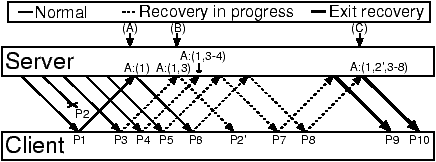
Figure 7: Trickles Recovery. First packet following loss triggers a retransmission (A). Trickles are subsequently terminated to deflate cwnd (B). Recovery ends when cwnd survivors are generated; cwnd has dropped from the original value of 5 to 2 (C).
In fast retransmit/recovery, TCP Reno uses duplicate acknowledgments
to infer the position of a lost packet (Figure 6). The lost packet is
retransmitted, the cwnd is halved, and transmission of new data
temporarily squelched to decrease the number of in-flight packets to
newCwnd. Likewise, Trickles uses its SACK proof to infer the location of lost
packets, retransmits these packets, halves the cwnd, and terminates a
sufficient number of trickles to deflate the number of in-flight
packets to newCwnd (Figure 7).
Fast retransmit/recovery is entered when the SACK proof contains a
loss. A successful fast retransmit/recovery phase is followed by a
congestion avoidance phase.
Since multiple trickles must execute the algorithm in parallel, each with a different
recovery role, the SACK prefix property is critical to proper
operation, as it allows each trickle to predict the input and recovery action of preceding trickles.
A client that violates the prefix property in packets it sends to the
server will cause inconsistent computations on the server side, and may
receive data and transport continuations redundantly or not receive them at all.
For request packet with packet number k during fast retransmit/recovery mode, Trickles performs the following operations:
-
firstLoss := sequence number of
first loss in input
cwndAtLoss := TCPCwnd(firstLoss - 1)
lossOffset := k - firstLoss
newCwnd := numInFlight / 2
The protocol variable firstLoss is derived from the SACK proof.
The SACK proofs for the trickle immediately after a loss,
as well as all subsequent trickles before recovery, will report a
gap. The SACK prefix invariant ensures
that each trickle will compute consistent values for the protocol
variables shown above.
- If k acknowledges the first packet after a run of losses,
retransmit the lost packets (Figure 7).
This is required to achieve the reliable delivery guarantees of TCP.
A burstLimit parameter, similar to that suggested for
TCP [1], limits the number of packets that may be
retransmitted in this manner; losses beyond burstLimit are
handled via a timeout and not via fast retransmit.
- The goal in fast retransmit is to terminate n = cwndAtLoss - newCwnd trickles, and
generate newCwnd survivor trickles. We choose to terminate the first n trickles, and
retain the last newCwnd trickles using the following algorithm:
(a) If cwndAtLoss - lossOffset < newCwnd, continue the
trickle. Otherwise, terminate the trickle.
(b) If k immediately follows a run of losses, generate the
trickles for all missing requests that would have satisfied (a).
Test (a) deflates the number of trickles to newCwnd. First, a
sufficient number of trickles are terminated to drop the number of
trickles to newCwnd. Then, all subsequent trickles become
survivors that will bootstrap the subsequent slow start/congestion
avoidance phase.
If losses occur while sending the surviving
trickles to the client, then the number of outstanding
trickles will fall below newCwnd. So condition (a) guarantees that
the new window size will not exceed the new target, while
condition (b) ensures that the new window will meet the target.
Note that when the server decides to recreate
multiple lost trickles per condition (b), it will not have access
to corresponding user continuations for the lost packets. Consequently,
the server transport layer cannot invoke the application and generate the
corresponding data payload. Instead, the server transport layer simply
generates the transport continuations associated with the lost trickles
and ships them to the client as a group. The client then regenerates the
trickles by retransmitting these requests to the server with matching user
continuations.
Following fast recovery, the simulation initial conditions are updated to reflect the conditions at the recovery sequence number:
TCPBase points to the recovery point, and ssthresh = startCwnd = newCwnd, reflecting the new window size.
Retransmit timeout
During a retransmit timeout, the TCP Reno sender sets ssthresh = cwnd
/ 2, cwnd = InitialCwnd, and enters slow start. In Trickles, the client kernel is
responsible for generating the timeout, as the server is stateless and
cannot keep such a timer. Let firstLoss be the first loss seen by the client
since the last retransmit timeout or successful recovery. For a retransmission timeout
request, the server executes the following steps to initiate slow start:
-
a := firstLoss
ssthresh := TCPCwnd(a-1)/2
cwnd := InitialCwnd
- Split cwnd - 1 times to generate cwnd survivors. Set
TCPCwnd(k) initial conditions to equivalent TCP post-recovery state.
2.6 Compatibility with TCP
Trickles is backward compatible with TCP in several
important ways, making it possible to incrementally adopt
Trickles into the existing Internet infrastructure. Compatibility
at the network level, due to similar wire format, similar
congestion control algorithm, and TCP-friendly behavior,
ensures interoperability with routers, traffic shapers, and
NAT boxes.
The client side of Trickles provides to the
client application a standard Berkeley sockets interface, so
the client application need not be aware of the existence of Trickles,
and only the client kernel needs modification
Trickles-enabled clients are compatible with existing
TCP servers. The initial SYN packet from a Trickles client
carries a TCP option to signal the ability to support Trickles.
Servers that are able to support Trickles respond to
the client with a Trickles response packet, and a Trickles
connection proceeds. Servers that understand only TCP
respond with a standard TCP SYN-ACK, causing the client to
enter standard TCP mode.
A Trickles server can also be compatible with standard TCP
clients, by handling standard TCP requests according to the
TCP protocol. Of course, the server cannot be stateless for
those clients, so some servers may elect to support only
Trickles.
3 Trickles server API
The network transport protocol described in Section 2
makes it possible to maintain a reliable communications
channel between a client and server with no per-connection state
in the server kernel. However, the real benefit of
statelessness is obtained when the entire server is
stateless. The Trickles server API allows servers to offload user-level state to the client, so that the
server machine maintains no state at any layer of the network stack.
3.1 The event queue
In the Trickles server API, the server
application does not communicate using per-connection file
descriptors, as these would entail per-connection state.
Instead, the API exports a queue of transport-level events to the
application. For example, client data packets and ACKs
appear as events. Since Trickles is stateless, events only occur in
response to client packets.
Upon processing a client request packet, the Trickles
transport layer may either terminate the trickle, or continue the associated trickle
and split off zero or more trickles. If the transport generates a response,
a single event is passed to the application, describing the incoming packet and all
the response trickles. The event includes all the data from
the request and also the user continuation from the request to the application.
API
state is linear in the number of unprocessed requests, which is
bounded by the ingress bandwidth.
The event queue eliminates a layer of multiplexing
and demultiplexing found in the traditional sockets API that can
cause excess processing overhead [4].
To avoid copying of events, the event queue is a synchronization-free linked list mapped in both the application
and kernel; it is mapped read-only in the application, and can be walked by the application without holding locks. While processing requests, the kernel
allocates all per-request data structures in the shared
region.
3.2 Minisockets
The Trickles API object that represents a remote endpoint is called
a minisocket.
Minisockets are transient descriptors that are
created when an event is received, and destroyed after being processed.
Like standard sockets, each minisocket is associated with
one client, and can send and receive data. Operationally, a
minisocket acts as a transient TCP control block, created
from the transport continuation in the associated packet.
Because the minisocket is associated with a
specific event, the extent of each operation is more limited.
Receive operations on the minisocket can only return input data from the
associated event, and send operations may not send more data
than is allowed by congestion control.
Trickles delivers OPEN, REQUEST, and CLOSE events when
connections are created, client packets are received, and clients
disconnect, respectively.
3.3 Minisocket operations
msk_send(int fd, minisock *, char *, size_t);
msk_sendv(int fd, minisock *, tiovec *, int);
msk_sendfilev(int fd, minisock *, fiovec *, int);
msk_setucont(int fd, minisock *, int pkt,
char* buf, size_t);
msk_sendbulk(int fd, mskdesc *, int len);
msk_drop(int fd, minisock *);
msk_detach(int fd, minisock *);
msk_extract_events(int fd, extract_mskdesc_in *,
int inlen, msk_collection *, int *outlen);
msk_install_events(int fd, msk_collection *, int);
msk_request(int fd, char *req, int reqlen,
int reservelen);
Figure 8: The minisocket API.
The minisocket API is shown in Figure 8.
Minisockets are represented by the structure
minisock *. All minisockets share the same file descriptor (fd),
that of their listen (server) socket. To send data with a minisocket, applications use
msk_send().
It copies packet data to the kernel, constructs and sends
Trickles response packets, then
deallocates the minisocket. msk_setucont() allows the
application to install user continuations on a per-packet basis.
Trickles also provides scatter-gather,
zero copy, and packet batch processing interfaces.
Allowing servers to directly manipulate the minisocket queue enables
new functionality not possible with sockets. Requests sent to a node
in a cluster can be redirected to a different node holding a cached
copy, without breaking the connection. During a denial of service
attack, a server may elect to ignore events altogether. The event
management interface enables such manipulations of the event queue.
While these capabilities are similar to those proposed in
[17] for TCP, Trickles can redistribute events at a
packet-level granularity.
The msk_extractEvents() and msk_insertEvents() operations manipulate
the event queue to extract or
insert minisockets, respectively. The extracted minisockets are protected against tampering by MACs.
Extracted minisockets can be migrated safely to
other sockets, including those on other machines.
4 Client-side processing
A Trickles client stack implements a Berkeley sockets
interface using the Trickles transport protocol.
Thus, the client application need not be aware of the presence of
Trickles. The
structure of Trickles allows client kernels to use a
straightforward algorithm to maintain the transport
protocol. The client kernel generates requests
using the transport continuations received from the server,
while ensuring that the prefix property
holds on the sequence of SACK proofs reported
to the server. Should the protocol stall, the client times
out and requests a retransmission and slow start.
In addition to maintaining the transport protocol, a client kernel
manages user continuations, storing new continuations and attaching
them to requests as appropriate. For instance, the client must provide
all continuations needed to generate a particular data request.
4.1 Standardized user continuations
To facilitate client-side management of continuations, and to simplify
server programming, Trickles defines standard user continuation formats
understood by servers and clients. These formats encode the mapping
between continuations and data requests, and provide a standard
mechanism for bootstrapping and generating new continuations.
Two kinds of continuations can be communicated between the client
and server: output continuations that the server
application uses to resume generating output to the client
at the correct point in the server's output stream, and input
continuations that the server application uses to help it
resume correctly accepting client input. Having separate
continuations allows the server to decouple input and
output processing.
4.2 Input continuations
When a client sends data to the server, it accompanies the data with
an appropriate input continuation, except for the very first packet
when no input continuation is needed. For single-packet client
requests, an input continuation is not needed. For requests that span
multiple packets, an input continuation contains a digest of the
data seen thus far. Of course, if the server needs lengthy input from
the client yet cannot encode it compactly into an input continuation,
the server application will not be able to remain stateless.
If, after receiving a packet from the client, the server application is unable to
generate response packets, it sends an updated input continuation back
to the client kernel, which will respond with more client data accompanied by
the input continuation. The server need not consume all of the client
data; the returned input continuation indicates how much input was
consumed, allowing the client's transmit queue to be advanced
correspondingly. The capability to not read all client data is
important because the server may not be able to compactly encode
arbitrarily truncated client packets in an input continuation.
4.3 Output continuations
When the server has received sufficient client data to begin
processing a request, it provides the client with an output
continuation for the response. The client can then use the output
continuation to request the response data.
For a web server, the output continuation might
contain an identifier for the data object being delivered,
along with an offset into that data object.
In general, the client kernel will have a number of output
continuations available that have arrived in various
packets from the server. Client requests include the requested ranges of data, along with the corresponding
output continuations. To allow the client to select the
correct output continuation, an output continuation
includes, in addition to opaque application-defined data,
two standard fields, validStart and validEnd, indicating the range
of bytes for which the output continuation can be used to generate data.
The client cannot request an
arbitrarily-sized range because the congestion control algorithm restricts the amount of data
that may be returned for each request. To compute the
proper byte range size, the client simulates the server's congestion
control action for a given transport continuation and SACK proof.
5 Optimizations
The preceding sections described the operation of the basic
Trickles protocol. The performance of the basic protocol is
improved significantly by three optimizations.
5.1 Socket caching
While the basic Trickles protocol is designed to be entirely
stateless, and thereby consume little memory, it can be easily
extended to take advantage of server memory when available. In
particular, the server host need not discard minisockets and
reconstitute the server-side TCB from scratch based on the
client continuation. Instead, it can keep minisockets for
frequently used connections in a server-side cache, and match
incoming packets to this pool via a hash table. A cache hit
will obviate the need to reconstruct the server-side state
or to validate the MAC hash on the client-supplied continuation.
When pressed for memory, entries in the minisocket cache can
simply be dropped, as minisockets can be recreated at any time.
Fundamentally, the cache acts as soft-state that can enable the
server to operate in a stateful manner whenever resources permit and reduce
the processing burden, while the underlying stateless protocol provides
a safety net in case the state needs to be reconstructed from scratch.
5.2 Parallel requests and sparse sequence numbers
The concurrent nature of Trickles enables a second optimization for
parallel downloads. Standard TCP operates serially, transmitting
streams mostly in-order, and immediately filling any gaps stemming
from losses. However, many applications, including web browsers, need to
download multiple files concurrently. With standard TCP, such
concurrent transactions either require multiple connections, leading
to well-documented
inefficiencies [15],
or complex application-level protocols, such as
HTTP 1.1 [11], for framing. In contrast, trickles are
inherently concurrent. Concurrency can improve the performance of both fetching and sending data to the server.
The Trickles protocol allows a client application to concurrently
request different, non-adjoining sequence number ranges from the
server on a single connection.
The response packets from the
server, which will carry data belonging to different objects
distributed through the sequence number space, will nevertheless be
subject to a single TCP-friendly flow equation, acting in effect like
a single, HTTP/1.1-like flow with application level framing. Since, in
some cases, the sizes of the objects may not be known in advance,
Trickles clients can conservatively dedicate large regions of the
sequence number space to each object. A server response packet may
include a SKIP
notification that indicates that the object ended before the end
of its assigned range. A client receiving a SKIP logically
elides the remainder of the object region,
without reserving physical buffer space,
passing it to applications, or waiting for
additional packets from the server. Consequently, the inherent
parallelism between Trickles can be used to multiplex logically
separate transmissions on a given connection, while subjecting them to
the same flow equation.
Trickles clients can also send multiple streams of data to the server
using the same connection. A stateless server is oblivious to the
number of different input sequences on a connection. By performing
multiple server input operations in parallel, a client can reduce the
total latency of a sequence of such operations.
5.3 Delta encoding
While continuations add extra space overhead to each packet,
predictive header compression can be used to drastically reduce the
size of the continuations transmitted by the server. Since the
Trickles client implementation simulates the congestion control
algorithm used by the server, it can predict the server's
response. Consequently, the server need only transmit those fields in
the transport continuation that the client mispredicts (e.g. a change
due to an unanticipated loss), or cannot generate (e.g.
timestamps). Of course, the server MAC still needs to be computed and
transmitted on every continuation, as the client cannot compute the
secure server hash.
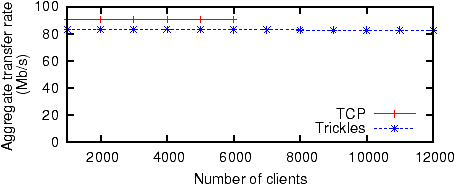
Figure 9: Aggregate throughput for Trickles and TCP. TCP fails for tests with more than 6000 clients.
6 Evaluation
In this section, we evaluate the quantitative performance of Trickles
through microbenchmarks, and show that it performs well compared to
TCP, consumes few resources, scales well with the number of clients,
and interacts well with other TCP flows. We also illustrate, through
macrobenchmarks, the types of new services that the Trickles approach enables.
We have implemented the Trickles protocol stack in the Linux
2.4.26 kernel. Our Linux
protocol stack implements the full transport protocol, the interface
and the SKIP and parallel request mechanisms described earlier.
The implementation consists of
15,000 total lines of code, structured as a loadable
kernel module, with minimal hooks added to the base kernel.
We use AES [9] for the keyed cryptographic hash function.
All results include at least six data points; error bars indicate
the 95% confidence interval.
All microbenchmarks in this section were performed on an isolated
Gigabit Ethernet using 1.7GHz Pentium 4's, with 512 MB RAM, and Intel
e1000 gigabit network interfaces.
To test the network layer in isolation, we served all
content from memory rather than disk.
6.1 Microbenchmarks
In this section, we use a high-performance server microbenchmark to
examine the throughput, scaling, and TCP-friendliness properties of Trickles.
Throughput
We tested throughput using a point-to-point topology with a single
server node placed behind a 100 Mb/sec bottleneck link. Varying
numbers of simultaneous client instances (distributed across two real
CPUs) repeatedly fetched a 500 kB file from the server. A fresh
connection was established for each request.
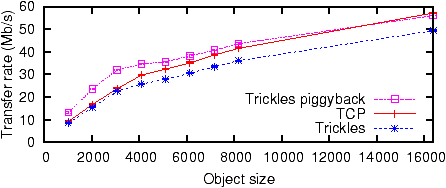
Figure 10: Trickles and TCP throughput for a single, isolated client at various object sizes.
Figure 9 shows that the aggregate throughput achieved by Trickles is within 10% of TCP at all client counts. Regular TCP consumes
memory separately for each connection to buffer outgoing data until it is
acknowledged. Beyond 6000 clients, TCP exhausts
memory, forcing the kernel to kill the server process. In contrast, the Trickles
kernel does not retain outgoing data, and recomputes
lost packets as necessary from the original source. Consequently, it does
not suffer from a memory bottleneck.
With Trickles, a client fetching small objects will achieve
significant performance improvements because of the reduction in the
number of control packets (Figure 10). Trickles
requires fewer packets for connection setup than TCP.
Trickles processes data embedded in SYN packets into output
continuations without holding state, and can send an immediate response;
to avoid creating a DoS amplification vulnerability,
the server should not respond with more data than it received.
In contrast, TCP must save or
reject SYN data; because holding state increases vulnerability to
SYN flooding, most TCP stacks reject SYN data.
Unlike TCP, Trickles does not require FIN packets to
clean up server-side state. The combination of SYN data and lower
connection overhead improves small file transfer throughput for
Trickles, with a corresponding improvement in transfer latency.
Memory and CPU utilization
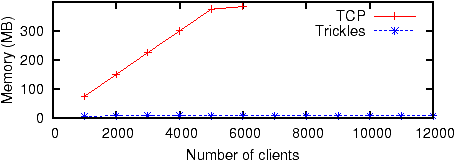
Figure 11: Memory utilization. Includes socket structures, socket buffers, and shared event queue.
We next examine the memory and CPU utilization of the Trickles
protocol. For this experiment, we eliminated the bottleneck link
in the network and connected the clients to the server through the
full 1Gb/sec link to pose a worst-case scenario.
Not surprisingly, Trickles consistently achieves better memory
utilization than TCP (Figure 11). TCP memory
utilization increases linearly with the number of clients, while
statelessness enables Trickles to uses a constant, small amount of memory.
Reduced memory consumption in the network
layer can improve system performance for a variety of
applications. In web server
installations, persistent, pipelined HTTP connections are known to
reduce download latencies, though they pose a risk because increased
connection duration can increase the number of simultaneous
connections. Consequently, many websites disable persistent connections
to the detriment of their users. Trickles can
achieve the benefits of persistent connections without suffering
from scalability problems. The low memory requirement of
Trickles also enables small devices with restricted amounts of
memory to support
large numbers of connections. Finally, Trickles's smaller memory
footprint provides more space for caching, benefiting all
connections.
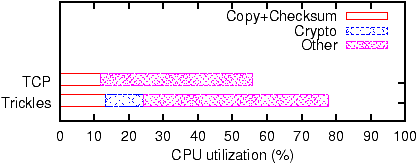
Figure 12: Server-side CPU overhead on a 1 Gb/s link.
Figure 12 shows a breakdown of the CPU overhead for
Trickles and TCP on a 1 Gb/s link when Trickles is reconstructing its
state for every packet (i.e. soft-state caching is turned off).
Not surprisingly, Trickles has higher CPU utilization
than TCP, since it verifies and recomputes state that it does not
keep locally. The overhead is evenly split between the cryptographic
operations required for verification and the packet processing required
to simulate the TCP engine. While the Trickles CPU overhead is higher, it does
not pose a server bottleneck even at gigabit speeds.
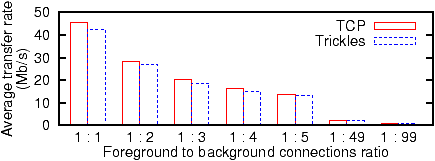
Figure 13: Interaction of Trickles and TCP.
Interaction with TCP flows
New transport protocols must not adversely affect existing flows on
the Internet. Trickles is designed to generate similar
packet-level behavior to TCP, and should therefore achieve similar
performance as TCP under similar conditions. To confirm this, we
measured the bandwidth achieved by Trickles in the presence of
background flows. We constructed a dumbbell topology with two servers on
the same side of a 100 Mb bottleneck link, and two clients on the other
side. The remaining links from the servers and clients to their
respective bottleneck routers operated at 1000 Mb. Each server was
paired with one client, with connections occurring only within each
server/client pair.
One pair generated a single “foreground” TCP or Trickles flow. The
other pair generated a variable number of background TCP flows. We
compared the throughput achieved by the foreground flow for Trickles
and TCP, versus varying numbers of background connections
(Figure 13). In all cases, Trickles performance
was similar to that of TCP.
Continuation optimizations
The SKIP and parallel continuation request mechanisms allow Trickles
to efficiently support pipelined transfers, enhancing protocol
performance over wide area networks. We verified their effectiveness over
WAN conditions by using nistnet [7] to introduce artificial
delays on a point-to-point, 100 Mb link. The single client
maintained 10 outstanding pipelined requests, and the server sent
advanced SKIP notifications when 50% of the file was
transmitted.
We compared the performance of TCP and Trickles for pipelined
connections over a point-to-point link with 10ms RTT. The file size was
250kB. This object size ensures that the link can be filled, independent
of the continuation request mechanism. Trickles achieves 86 Mb/s, and
TCP 91 Mb/s. Thus, with SKIP hints Trickles achieves performance similar
to that of TCP.
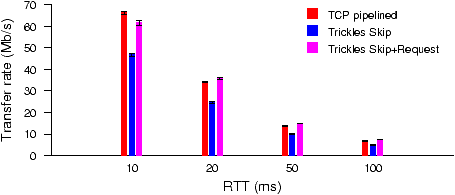
Figure 14: Throughput comparison of pipelined transfers with 20 kB objects, smaller than the bandwidth-delay product.
We also verified that issuing continuation requests in parallel improves
performance. We added the msk_request() interface that takes
application-specified data and reliably transmits the data to the
server for conversion into an output continuation. These requests are
non-blocking, and multiple such requests can be pending at any time.
In Figure 14, the object sizes are
small, so a Trickles client using SKIP with the
sockets interface cannot receive output continuations quickly enough
to fill the link. The Trickles client supporting parallel requests
can receive continuations more frequently, resulting in performance
comparable to TCP.
Summary
Compared to TCP, Trickles achieves similar or better throughput
and scales asymptotically better in terms of memory. It
is also TCP-friendly.
Trickles incurs a significant CPU
utilization overhead versus baseline TCP, but this additional CPU
utilization does not pose a performance bottleneck even at gigabit speeds.
The continuation management mechanisms
allow Trickles to achieve performance comparable to TCP
over a variety of simulated network delays and with both pipelined and
non-pipelined connections.
6.2 Macrobenchmarks
The stateless Trickles protocol, and the new event-driven Trickles
interface, enable a new class of stateless services. We examine three
such services, and we also evaluate Trickles under
real-world network loss and delay.
PlanetLab measurements
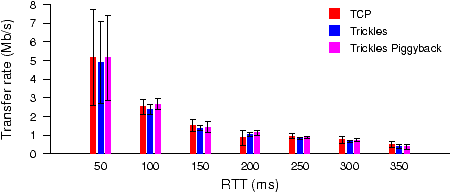
Figure 15: Trickles and TCP PlanetLab throughput.
We validated Trickles under real Internet conditions using PlanetLab [5]. We ran a
variant of the throughput experiment in which both the server and the client
were located in our local cluster, but with all traffic between the two nodes
redirected (bounced) through a single PlanetLab node m. Packets are first
sent from the source node to m, then from m to the destination node. Thus,
packets incur twice the underlying RTT to PlanetLab.
Figure 15 summarizes the average throughput for a 160kB
file. PlanetLab nodes are grouped into 50 ms bins by the RTT measured by the endpoints. Trickles achieves similar
performance to TCP under comparable network conditions.
Instantaneous failover
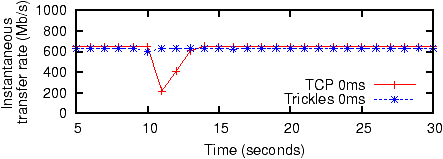
Figure 16: Failover behavior. Disconnection occurs at t=10 seconds.
Trickles enables connections to fail over from a failed server to
a live backup simply through a network-level redirection. If network
conditions do not change significantly during the failover to invalidate
the protocol parameters captured in the continuation, a server replica
can resume packet processing transparently and seamlessly.
In
contrast, TCP recovery from server failure fundamentally requires
several out of band operations. TCP needs to detect the disconnection,
re-establish the connection with another server, and then
ramp back up to the original data rate.
We compared Trickles and TCP failover on a 1000 Mb single
server/single client connection. At 10 seconds, the server application
is killed and immediately restarted. Figure 16
contains a trace illustrating the recovery of Trickles and TCP.
Since transient server failures are equivalent to packet loss at the
network level, Trickles flows can recover quickly and transparently
using fast recovery or slow start. The explicit recovery steps needed by TCP increases its recovery time.
Packet-level load balancing
Trickles requests are self-describing, and hence can be processed by
any server machine. This allows the network to freely dispatch request
packets to any server. With TCP, network level redirection must ensure
that packets from a particular flow are always delivered to the same
server. Hence, Trickles allows load balancing at packet
granularity, whereas TCP allows load balancing only at
connection granularity.
Packet-level granularity improves bandwidth allocation. We used
an IP layer packet sprayer to implement a clustered web server with two servers and two clients. The IP
packet sprayer uses NAT to present a single external server IP to the clients.
In the
test topology, the clients, servers, and packet sprayer are connected
to a single Ethernet switch. The servers are connected to the
switch at 100 Mb to introduce a single bottleneck on the
server--client path.
TCP and Trickles tests used different load balancing algorithms. TCP
connections were assigned to servers using the popular
“least
connections” heuristic, which permanently assigns new TCP
connections to the node with the least number of connections at arrival time. Trickles
connections were processed using a per-packet
algorithm that dispatched packets on a round-robin schedule.

Figure 17: Jain's fairness index in load balancing cluster
with two servers and two clients. Allocation is fair when
each client receives the same number of bytes.
Figure 17 compares the
Jain's fairness index[14] of the
total throughput versus the uniform allocation. For
most data points, Trickles more closely matches the uniform
distribution than TCP does.
Dynamic content
Loss recovery in a stateless system may require the recomputation
of past data; this is more challenging for dynamic content. To demonstrate the generality of stateless servers, we implemented a
watermarking media server that modifies standard media files to custom versions containing a client-specific watermark.
Such servers are relevant for DRM media distribution
systems, where content providers may apply
client-specific transforms to digital media before
transmission. Client customization inherently prevents multiple
simultaneous downloads of the same object from sharing socket
buffers, thus increasing the memory footprint of the network stack.
We built a JPEG watermarking application that provides useful insights into
continuation encoding for stateless operation. JPEG relies on Huffman
coding of image data, which requires a non-trivial
continuation structure. The exact bit position of a particular symbol after
Huffman coding is not purely stateless, as it is dependent on the bit
position of the previous symbols.
In our Trickles-based implementation of such a server, the output
continuation records the bit alignments of encoded JPEG coding units
at regular intervals. When generating output continuations, the
server runs the watermarking algorithm to determine these bit positions,
and discards the actual data. While processing a request, the server consults the bit positions in the
output continuation for the proper bit alignment to use for the
response.
7 Related Work
Previous work has noted the enhanced scalability and security
properties of stateless protocols and algorithms. Aura et al. [2] developed a general framework for
converting stateful protocols to stateless protocols, and applied this to authentication protocols, and noted
denial-of-service resilience and potential for anycast applications as
benefits of stateless protocols. Trickles deals with the more
general problem of streaming data, provides a high performance stateless
congestion control algorithm. Stateless Core Routing (SCORE) [22] redistributes state in routing algorithms to improve
scalability.
Rather than placing state at the core routers, where holding state is expensive and often
infeasible, SCORE moves the state to the edge of the network.
Continuations are used in several existing systems. SYN cookies are a classic modification to TCP that
uses a simple continuation to eliminate per-connection state during
connection
setup [6, 27]. NFS directory cookies [25] are application continuations.
Continuations for Internet services have been explored at a coarser granularity than in
Trickles. Session-based mobility [21] adds
continuations at the application layer to support
migration and load balancing. Service
Continuations [23, 24] record state
snapshots, and move these to new servers during migration. In these
systems, continuations are large and used infrequently in explicit migration
operations controlled by connection endpoints. Trickles provides
continuations at packet level, enabling new functionality within the
network infrastructure.
Receiver-driven protocols [12, 13] provide clients with
more control over congestion control. Since
congestion often occurs near clients, and is consequently more readily detectable
by the client, such systems can adapt to congestion more
quickly. Trickles contributes a secure, light-weight congestion
control algorithm that enforces strong guarantees on receiver
behavior.
Several kernel interfaces address the memory and
event-processing overhead of network stacks. IO-lite [18]
reduces memory overhead
by enabling buffer sharing between different connections and the
filesystem.
Dynamic buffer tuning [20]
allocates socket
buffer space to connections where it is most
needed.
Event interfaces such as
epoll(), kqueue(), and others [16, 4]
provide efficient mechanisms for
multiplexing events from different connections.
8 Conclusions and future work
Trickles demonstrates that it is possible to build a completely
stateless network stack that offers many of the desirable properties
of TCP; namely, efficient, reliable transmission of data streams between two
endpoints. As a result, the stateless side of a Trickles connection
can offer good performance with a very small memory footprint.
Statelessness in Trickles extends all the way into applications: the
server-side API enables servers to export their state to the client
through a user continuation mechanism. Cryptographic hashes prevent
untrusted clients from tampering with server state. Trickles is
backwards compatible with existing TCP clients and servers, and can be
adopted incrementally.
Beyond efficiency and scalability, statelessness enables new
functionality that is awkward or impossible in a stateful
system. Trickles enables load-balancing at packet granularity,
instantaneous failover via packet redirection, and transparent
connection migration. Trickles servers may be replicated,
geographically distributed, and contacted through an anycast
primitive, and yet provide the same semantics as a single stateful
server.
Statelessness is a valuable property in many domains.
The techniques used to convert TCP to a stateless
protocol---for example, the methods for working around
the intrinsic information propagation delays---may also
have applications to other network protocols and distributed
systems.
Acknowledgments
We would like to thank Paul Francis, Larry Peterson,
and the anonymous reviewers for their feedback.
This work was supported by the Department of the Navy,
Office of Naval Research, ONR Grant N00014-01-1-0968; and
National Science Foundation grants 0208642, 0133302, and
0430161. Andrew Myers is supported by an Alfred P. Sloan
Research Fellowship. Opinions, findings, conclusions, or
recommendations contained in this material are those of the
authors and do not necessarily reflect the views of these
sponsors. The U.S. Government is authorized to reproduce and
distribute reprints for Governmental purposes
notwithstanding any copyright notation thereon.
References
- [1]
M. Allman, V. Paxson, and W. Stevens.
TCP Congestion Control.
RFC 2581, Apr. 1999.
- [2]
T. Aura and P. Nikander.
Stateless Connections.
In Proceedings of the International Conference on Information
and Communication Security, pages 87--97, Beijing, China, Nov. 1997.
- [3]
H. Ballani and P. Francis.
Towards a Deployable IP Anycast Service.
In Proceedings of the Workshop on Real, Large Distributed
Systems, San Francisco, CA, Dec. 2004.
- [4]
G. Banga, J. C. Mogul, and P. Druschel.
A Scalable and Explicit Event Delivery Mechanism for UNIX.
In Proceedings of the USENIX Annual Technical Conference,
pages 253--265, Monterey, CA, June 1999.
- [5]
A. Bavier, M. Bowman, B. Chun, D. Culler, S. Karlin, S. Muir, L. Peterson,
T. Roscoe, T. Spalink, and M. Wawrzoniak.
Operating Systems Support for Planetary-Scale Network Services.
In Proceedings of the Symposium on Networked Systems Design and
Implementation, San Francisco, CA, Mar. 2004.
- [6]
D. Bernstein.
SYN Cookies.
http://cr.yp.to/syncookies.html.
- [7]
M. Carson and D. Santay.
NIST Net.
http://www-x.antd.nist.gov/nistnet.
- [8]
R. Chakravorty, S. Banerjee, P. Rodriguez, J. Chesterfield, and I. Pratt.
Performance Optimizations for Wireless Wide-Area Networks:
Comparative Study and Experimental Evaluation.
In Proceedings of MobiCom, Philadelphia, PA, Sept. 2004.
- [9]
J. Daemen and V. Rijmen.
AES Proposal: Rijndael, 1999.
- [10]
D. Ely, N. Spring, D. Wetherall, S. Savage, and T. Anderson.
Robust Congestion Signaling.
In Proceedings of the International Conference on Network
Protocols, pages 332 -- 341, Riverside, CA, Nov. 2001.
- [11]
R. Fielding, J. Gettys, J. Mogul, H. Frystyk, L. Masinter, P. Leach, and
T. Berners-Lee.
Hypertext Transfer Protocol -- HTTP / 1.1.
RFC 2616, June 1999.
- [12]
R. Gupta, M. Chen, S. McCanne, and J. Walrand.
A Receiver-Driven Transport Protocol for the Web.
In Proceedings of INFORMS, San Antonio, TX, Nov. 2000.
- [13]
H.-Y. Hsieh, K.-H. Kim, Y. Zhu, and R. Sivakumar.
A Receiver-Centric Transport Protocol for Mobile Hosts with
Heterogeneous Wireless Interfaces.
In Proceedings of MobiCom, San Diego, CA, Sept. 2003.
- [14]
R. Jain.
The Art of Computer Systems Performance Analysis: Techniques for
Experimental Design, Measurement, Simulation, and Modeling.
John Wiley and Sons, Inc., 1991.
- [15]
B. Krishnamurthy, J. C. Mogul, and D. M. Kristol.
Key Differences between HTTP/1.0 and HTTP/1.1.
In Proceedings of the World Wide Web Conference, Toronto,
Canada, May 1999.
- [16]
J. Lemon.
Kqueue: A Generic and Scalable Event Notification Facility.
In Proceedings of the USENIX Annual Technical Conference,
Boston, MA, June 2001.
- [17]
J. Mogul, L. Brakmo, D. E. Lowell, D. Subhraveti, and J. Moore.
Unveiling the Transport.
SIGCOMM Computer Communications Review, 34(1):99--106, 2004.
- [18]
V. S. Pai, P. Druschel, and W. Zwaenepoel.
IO-Lite: A Unified I/O Buffering and Caching System.
In Proceedings of the Symposium on Operating Systems Design and
Implementation, New Orleans, LA, Feb. 1999.
- [19]
S. Savage, N. Cardwell, D. Wetherall, and T. Anderson.
TCP Congestion Control with a Misbehaving Receiver.
SIGCOMM Computer Communications Review, 29(5):71--78, 1999.
- [20]
J. Semke, J. Mahdavi, and M. Mathis.
Automatic TCP Buffer Tuning.
In Proceedings of ACM SIGCOMM, Vancouver, Canada, Aug. 1998.
- [21]
A. C. Snoeren.
A Session-Based Approach to Internet Mobility.
PhD thesis, Department of Electrical Engineering and Computer
Science, Massachusetts Institute of Technology, Dec. 2002.
- [22]
I. Stoica.
Stateless Core: A Scalable Approach for Quality of Service in
the Internet.
PhD thesis, Department of Electrical and Computer Engineering,
Carnegie Mellon University, 2000.
- [23]
F. Sultan.
System Support for Service Availability, Remote Healing and
Fault Tolerance Using Lazy State Propagation.
PhD thesis, Division of Computer and Information Sciences, Rutgers
University, Oct. 2004.
- [24]
F. Sultan, A. Bohra, and L. Iftode.
ervice Continuations: An Operating System Mechanism for Dynamic
Migration of Internet Service Sessions.
In Proceedings of the Symposium on Reliable Distributed
Systems, Florence, Italy, Oct. 2003.
- [25]
Sun Microsystems.
NFS: Network File System Protocol Specification.
RFC 1094, Mar. 1989.
- [26]
G. Wright and W. Stevens.
TCP/IP Illustrated, Volume 2.
Addison-Wesley Publishing Company, Reading, MA, Oct. 1997.
- [27]
A. Zķquete.
Improving the Functionality of SYN Cookies.
In Proceedings of the IFIP Communications and Multimedia
Security Conference, Portoroz, Slovenia, Sept. 2002.
|
